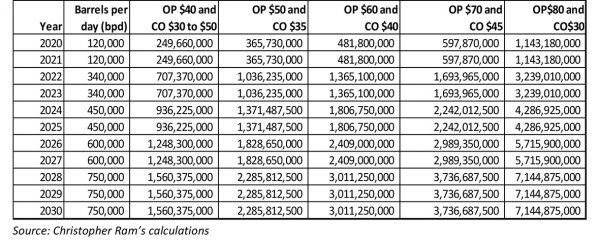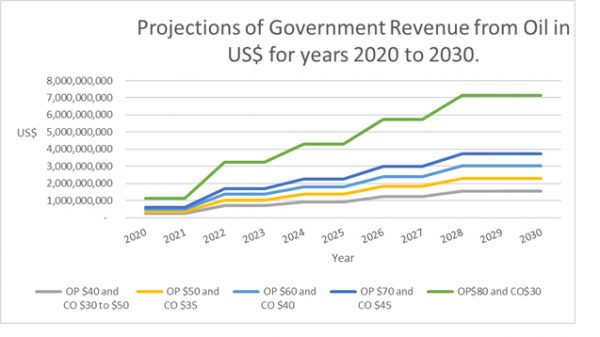Introduction
It has been over one month since the Ministry of Finance tabled in the National Assembly a fifty-one page document which it claims presents “preliminary proposals” to stimulate discussion on its plan for managing the flows from petroleum operations following first oil estimated to flow by the end of the first quarter of 2020. Central to the proposal are what is called the “fiscal rule”, embodied in the second element and that is a Natural Resource Fund to be established under a Natural Resource Fund Act.
I have projected that revenue from petroleum within the next calendar decade will account for approximately eighty percent of government revenues with both negative and positive implications for generations to come. Will we go the way of so many countries of which Nigeria, Venezuela and Democratic Republic of the Congo seem to be the poster children, unable to use their natural resources to improve the wellbeing of their people, reduce the wealth and income gap and fairly distribute their patrimony among all their people – born and unborn? Or could we follow the path of Chile and Botswana which have used very similar resources but pursuing a very different path, to transform their countries and the lives of their people? Of course in so many ways, Singapore, without any natural resources, has been an outstanding example, if not of a political model, but of what inspired vision and leadership can do for a country.
Oil take
My selection from a range of the Government’s Take of Oil Revenue expected from 2020 to 2030 is set out in the Table below. For purposes of the projections I have selected production levels ranging from 120,000 barrels per day (bpd) in 2020 to 750,000 bpd in 2030. Note that these projections relate only to the Esso/Hess/CNOOC and the discoveries announced to date. That the oil price (OP) is one of the most volatile variables is well known and the projections cover a range of possible oil prices, from US$40 per barrel to US$80 per barrel and Cost Oil (CO) ranging from US$30 to US$50.
Readers would appreciate that such variations would result in a large number of scenarios. However, for purposes of this column, I outline below the numbers over 5 specific variations.
Projections of Government Revenue from Oil in US$ for years 2020 to 2030:

Too busy
I was one of four panelists at a Discussion Forum yesterday, organised by the Guyana Manufacturing and Services Association, the others being trade unionist Lincoln Lewis, Carol Webster, Consultant and University Lecturer and Ramesh Persaud, Chartered Accountant and CEO of IPED. My understanding is that Dr. Mark Bynoe who was selected by President Granger to head the recently established Petroleum Department in the Ministry of the President was too busy to attend the Forum at which the Government’s position was presented by Ms. Sonya Roopnauth, Budget Director.
Given President Granger’s expectation that Dr. Bynoe knew nothing of the petroleum sector but would be expected to learn on the job, “being busy” could hardly be justification for missing such an important consultation. Indeed it would not have been asking too much to have had both Minister of Finance Winston Jordan and Dr. Bynoe present to articulate what is in fact a Policy Paper instead of Ms. Roopnauth who, despite being indefatigable and immensely competent, is a technocrat and who is in the middle of budget consultations.
The Government has indicated that it proposes to introduce the Natural Resources legislation before the end of 2018 even though its only work to promote the Green Paper has been more in the nature of PR and propaganda in paid advertisements in the print media. Once again Lincoln Lewis had to draw attention to the Government’s complete disregard of Articles 13 and 149 C of the Guyana Constitution requiring consultation with and the participation of the people. This failure drew pointed comments from the floor, including a representative from the Amerindian community and from the Human Rights Association.
Conclusion
Net week, I hope to go into the Paper in some depth but for now, I have to note that this is not a Green Paper but a White Paper. A Green Paper is a genuine discussion paper with broad objectives set out and a range of options, identifying their advantages and limitations and not unusually, asking specific questions of readers. This Paper does no such thing. In fact, it is emphatic and unambiguous about what the Government will do, how it will do it and who will do it – a Minister of course. The second preliminary point is that this Paper was driven largely by the Commonwealth Secretariat, the same organisation that authored our 1986 Petroleum Legislation that has us in the mess we are in. Everything about this Government’s oil and gas policy is shaped by and favours “foreign” while Guyanese organisations and individuals struggle to put in some “local content”!
Until next week. You can also read this column at chrisram.net.






